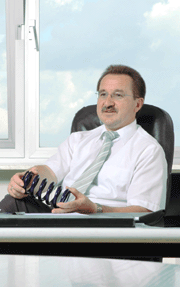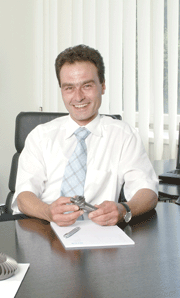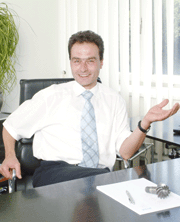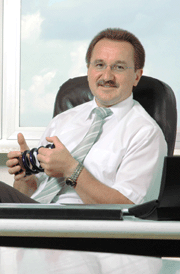E-Archive
Interview
in Vol. 6 - September Issue - Year 2005
Shot Peening - An Ancient Art And A Modern Technology

Hubert Prokopp, Managing Director in Hagen, Germany

Dr. Harald Reinach, Vice President Technique in Schaffhausen, Switzerland

Dr. Harald Reinach

Hubert Prokopp
Interview with Dr. Harald Reinach, Vice President Technique and Mr. Hubert Prokopp, Managing Director of DISA Industrie AG.
MFN continues its interview series. It approached DISA Industrie AG, one of the world’s largest manufacturers of wheel blasting and peening equipment to talk in particular about the technology and process itself. Dr. Harald Reinach, Vice President Technique in Schaffhausen and Mr. Hubert Prokopp, Managing Director in Hagen, are responsible for engineering and R&D for blasting and peening equipment in Europe and accepted MFN‘s request.
(?) MFN: Your company, DISA, has been active for decades in the blast technology segment, which has been applied in foundries, in the mechanical descaling segment, and also in shot-peening. Are we talking about an established technology or about a process that first needs to win recognition?
(!) Harald Reinach: Actually it’s both, but let me go back a bit further: “To clean and refine glass, stone, metal and other hard materials by means of a sandblast stream, which is driven forwards by compressed air of varying density”, was the claim of an industrial property right filed in 1871 by Benjamin Tilghman, on which the entire development of shot blast technology is based.
Shot peeing is the further development and perfected rendition of shot blasting. It is a cold forming process, with which internal residual compressive stress is induced into the zone close to the surface of the work pieces to be processed. Shot-peening replaces complex, cost-intensive processes and reduces material costs. It allows the design of lighter weight components, thus increasing the strength/weight characteristics and the cost/benefit of the work piece.
(?) MFN: Today various work principles are applied in shot-peening, such as compressed air blasting and others using blast wheels. Are both methods justified in their own right or is one or the other technology superfluous?
(!) Harald Reinach: In air blasting, steel shot or ceramic blasting media are accelerated by means of compressed air and specifically steered towards the component via nozzles. The blasting media is accelerated up to 220 m/s. In order to achieve an optimal covering ratio, the nozzles are controlled stationary, moving in steps, or oscillating. Air blasting is used for components that have to be blasted in precisely defined areas and with a high energy flow.
The use of modern wheel blast systems can perceptibly increase the flow rate of blasting media, i.e. treated surface per time. The energy flow of air blasting compared with wheel blasting is approx. 1 : 10, or to put it another way: the processing costs can be decisively reduced via wheel blasting. However, process security has to be ensured. Maximum reproducibility of all blast parameters such as blast velocity, blast time, shot flow rate, and angle of impact is mandatory and possible.
One could thus conclude that air blasting should be used when necessary, wheel blasting when possible.
(!) Hubert Prokopp: Today wheel blasting is primarily used to process larger batches of components subject to heavy and alternating stresses. Traditional fields of application are vehicle construction (automobile industry, rolling stock), the machinery industry or, from the point of view of the part spectrum, springs of all types, shafts, gear wheels, crank shafts, piston rods, camshafts. Tools for the mining industry, stabilisers, etc. are also shot-peened using the blast wheel technology.
Another process is so-called stress-peening, e.g. shot-peening under pre-tension. In the case of parts that are only stressed in one direction, and of which higher durability is demanded than that which can be achieved with conventional shot-peening, the stress-peening process is used, whereby the parts are shot-peened in pre-tensioned or stretched state. During the process an even higher internal compressive stress is generated than with conventional shot-peening and, in fact, right to the internal compression stress flow limit of the material. Stress-peening produces additional weight savings and further increases in service life.
(?) MFN: You spoke about the positive effects of shot-peening. Could you be more specific?
(!) Hubert Prokopp: The improvements effectively achieved are of course heavily dependent on the individual application. But one could, for instance, provide the following as approximate values for the increase in service life:
Piston rods 45 – 100%
Torsion bars 140 – 600%
Gear wheels > 1000%
Weld seams 200%
Coil springs up to > 1000%
Increase in the dynamic strength of springs in the range of 20 to 100%. However, other aspects, e.g. a weight-limited part design may also be a priority.
(?) MFN: What conditions must technologically optimized shot-peening meet?
(!) Harald Reinach: In order to increase durability and to avoid stress corrosion cracking it is imperative that the critical surfaces are completely shot-peened, i.e. at least complete coverage is achieved. The complete coverage ratio is defined as the equal and complete indentation of the original surface of the parts to be shot-peened. Monitoring is ensured visually by using a 10x magnifying glass or a liquid, which is applied by painting, spraying or dipping. During the drying process this liquid forms an elastic coating, which can only be removed by breaking the surface. With the aid of UV lighting one checks whether all surfaces to be blasted are covered with the film. The sample parts are then shot-peened until the necessary intensity and coverage is achieved. Another check is then made under UV lighting as to whether the film has been completely removed. Complete coverage is characterised by the complete removal of the film during blasting. Surfaces, which are not completely covered, have a yellow-green fluorescent colour under UV lighting. This process has been approved by the US-Military specification MIL-S-13165-B.
(!) Hubert Prokopp: A common gauge for shot-peening is the so-called Almen value and/or Almen test. In this an equalised spring steel strip is exposed to shot blasting on one side for a time. The extent of the deflection of the strip, which is determined via a dial gauge, is the Almen value. However, it is now incorrect to assume that the highest possible Almen value is also identical to the greatest increase in fatigue resistance. Rather, trials are needed to determine under what prerequisites the greatest increase is possible, i.e. parts have to be shot-peened with various shot sizes, shot speeds and dwell times in a series of experiments. These in turn are subjected to test facilities of a number of load variations, whereby the optimum shot peen process parameter values are determined. An Almen value achieved with this combination is then a reference dimension for the shot-peening system to be created for recurring shot-peening work and/or quality of the parts to be processed. This is one of the reasons that we usually carry out a series of blast trials in our test lab in the preliminary stages of a project. In this way the systems can be ideally reconciled with the customer’s requirements. Of course, many other influencing factors should be taken into account, e.g. shot dosage and reconditioning, It would, however, take too long to go into all of them in detail.
(?) MFN: What demands do you make of the shot?
(!) Harald Reinach: Shot of various sizes with a high tensile strength and / or hardness are accelerated via blast wheel turbines and thrown onto the work-pieces, whereby in addition to the dwell time, the grain size, the impact angle as well as the impact speed of the individual grains influence the result. Shot size, or grain size, and speed are the two components in the equation for kinetic energy.
Formula: E = (m × v²) / 2
It is obvious that with a heavy mass and a high speed the kinetic energy increases. In order to be able to achieve an optimal result, not just the kinetic energy, but also the coverage ratio is important. Both factors are also influenced by the blasting media to be used. Depending on the individual application round cast steel, or pre-rounded steel cut wire (steel or stainless steel), glass or ceramic substances are used. The degrees of hardness usually range between HRC 45 – HRC 70. Furthermore, it has to be considered that the work-pieces are not shot-peened excessively.
(!) Hubert Prokopp: At this point, we should also talk about the significance of the grain size distribution. The spherical particles thrown at high speed from the blast wheel turbines plastically distort the substance’s surface. This causes a surface cold working deformation, due to lattice deformations in the crystallites. The internal residual compressive stress generated in this way in the zone close to the surface prevents the formation and propagation of cracks. It is a known fact that a crack within an internal compressive layer does not spread. As almost all fatigue cracks and stress corrosion cracking emanate from the surface, the internal residual compressive stress generated by shot-peening the surface is the cause of the multiple increase in service life. Due to the grain decay (abrasion of the blast media), after a certain operating time an operating mixture materialises. As soon as a blast machine is commissioned a blasting mixture should be used according to existing empirical values. The stationary condition (operating mixture) only remains if new grain is continually added in the correct dosage. The dosage is oriented towards the blast media consumption. Delay in the refill amount reduces the amount of larger grains, with the blast flow decreasing and the blasting time increasing. By contrast, if larger amounts of a new blasting agent are refilled at once, the required amount of smaller grains decreases, the surface then becomes rougher in the case of unchanged initial roughness depth. At the same time the contact ratio deteriorates. Automatic refill devices ensure a constant operating mixture. The upper grain limit in the operating mixture is determined by the largest dimension within the blast media class. The smallest grain size in the blend is determined by the setting of the separator.
(?) MFN: What are the technical perspectives in your view?
(!) Harald Reinach: In the wheel blast system segment simple manually operated systems, which allow a great deal of flexibility, will continue to exist. In the production of a series of similar geometry and dimensions we will see an increased number of fully automatic autonomous manufacturing cells. In this case, loading and unloading is performed by means of handling devices or robots. Cost effectiveness can be increased by reducing personnel costs and increasing efficiency. Upstream and downstream functions are possible. Cell solutions require clear interfaces and clearly defined process workflows to the other functions. The modularity and flexibility of the systems is important criterion, in order to be able to make rapid adjustments in the case of changing process steps. In closure it should be said that after weighing technology, quality and cost effectiveness, the application of shot-peening with blast wheel technology has a definite place in the pursuit of greater fatigue strength. For many future applications blast wheel blasting will not just be an alternative, but also the appropriate solution.
We at MFN would like to thank Dr. Harald Reinach and Mr. Hubert Prokopp for this interview.
For Information:
DISA Industrie AG
P.O. Box
8207 Schaffhausen, Switzerland
Tel. +41.52.631 1717, Fax 631 4888
E-mail: info.sh@disagroup.ch
www.disagroup.com



























